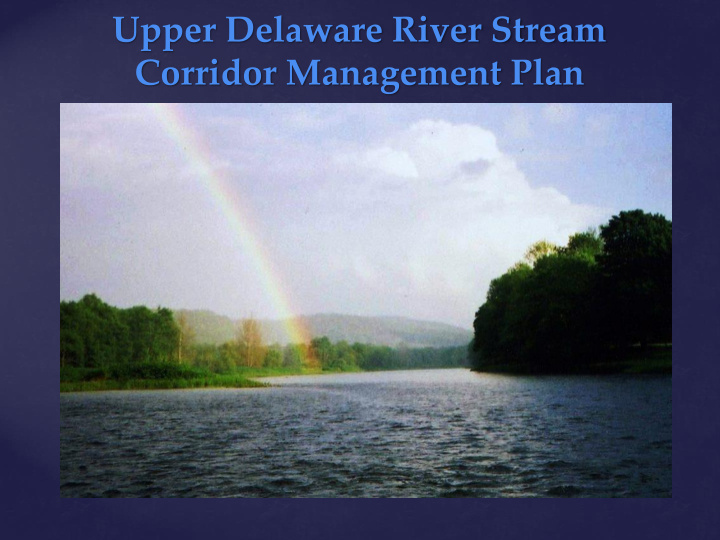



Upper Delaware River Stream Corridor Management Plan
Stream Corridor Management Plan Components 1. Community Outreach 2. Vision and Goals 3. Watershed Characterization 4. Management Recommendations 5. Implementation Strategy and Schedule
Stream Corridor Management Area Overview
Stream Corridor Management Plan The Vision “a comprehensive guidance document that will highlight opportunities maintain, enhance, conserve and restore stream systems, water quality, and habitat to promote a healthy Upper Delaware River ecosystem and increase recreation and tourism opportunities.” “…..non -regulatory, multi-jurisdictional blueprint for the future management, conservation, and restoration of of waterways in Delaware county, NY…” “The SCMP will be developed with maximum public participation and involvement and will be embraced by all watershed stakeholders…”
Stream Corridor Management Plan The Goals 1. Involve all watershed stakeholders, generate broad public support for the plan, and ensure long term implementation of the plan. 2. The plan will promote a vibrant, sustainable economy including recreation, tourism, and resource based industries. 3. Improve infrastructure, mitigate flood threats, and identify sustainable flood response actions to protect communities and natural resources. 4. Promote revisions to the Flexible Flow Management Plan that result in sustainable water releases, normalized sediment transport, and suitable habitat conditions and stream temperatures.
Stream Corridor Management Plan The Goals 5. Address excessive tributary erosion and sedimentation. And encourages bank stability and floodplain reconnection 6. Gain a better understanding of watershed characteristics by gathering relevant data that will assist in the development of voluntary management recommendations 7. Develop a list of on the ground projects that support the recommendations and promote opportunities for a diversity of partnerships and funding sources.
Stream Corridor Data Evaluation Climate Geology Water Cycle Soils Land Use Riparian Area Land Cover Surface Water Groundwater
Goal: Reduce impacts of flooding on public health, safety and infrastructure Identify opportunities for flood mitigation • Which Buildings and Infrastructure within flood zones are most flood prone and have the most negative impact to the community if damaged. • Identify undersized bridges and culverts and prioritize which potential road closure would cause the longest detour (or isolation) • Identify water quality pollution sources that occur during a flood • Ensure “flood smart” economic growth in the areas that are flood prone
Stream Corridor Management Plan FEMA Map - Deposit
Stream Corridor Management Plan Road Stream Crossings and Dams {
Stream Corridor Management Plan Road Stream Crossings Assessments {
Stream Corridor Management Plan Road Stream Crossing Replacements {
Reduce impacts of flooding on public health, safety and infrastructure Floodplain Protection and Restoration Identify ways to reconnect floodplain to reduce flood water elevations Village of Walton - after Village of Walton - before Photo Credit: Graydon Village of Walton - after Dutcher
Goal: Restore and protect stream systems, water quality and habitat Identify sources of water quality and habitat degradation NYS Classification A/AA: Drinking B: Recreation C: Fishing D: Fishing; no propagation Highlighted blue=trout/trout spawning C(T) or C (TS)
Goal: Restore and protect stream systems, water quality and habitat Identify sources highly erodible soils
Restore and protect stream systems, water quality and habitat Identify sources of water quality and habitat degradation • Bank erosion • Riparian area modification • Septic tanks • Livestock
Restore and protect stream systems, water quality and habitat Identify locations of high quality habitat • Wetlands • Ponds/Lakes • Streams/Rivers • Areas of coldwater Instream • Areas of groundwater recharge Wetlands Riparian area • Forested headwaters Headwater streams
Goal: Restore and protect stream systems, water quality and habitat Identify locations of high quality habitat
Stream Corridor Management Land Cover Comparison Downsville Downsville
Goal: Restore and protect stream systems, water quality and habitat Restore and protect riparian vegetation
Goal: Restore and protect stream systems, water quality and habitat Restore and protect riparian vegetation Exhibit?
Restore and protect stream systems, water quality and habitat Reduce flow variability and maintain sustainable river flows
Promote Revisions in the NYC Delaware River Basin reservoir management plan (FFMP) Consistent water releases to protect aquatic habitat Address thermal relief protocol Eliminate “yo - yo” releases and impacts
Stream Corridor Management Plan Priority Subwatershed Assessments
Stream Corridor Management Plan Priority Subwatershed Assessments Legend ! Oquaga Creek Road Stream Crossings Berms Erosive_feature Oquaga Creek and Tributaries Oquaga Creek Watershed Outline
Stream Corridor Management Plan Next Steps
Recommend
More recommend